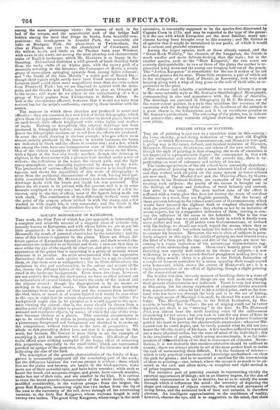FINE ARTS.
HARDING'S PARK AND FOREST TREES.
UNDER the title of The Park and the Forest, Mr. HARDING has pro- duced a volume of vigorous and masterly sketches of trees in conjunc- tion with landscape scenery : they are attractive on account of their picturesque beauty, and valuable as studies of the characters of foliage, for the use of the student and amateur. Mr. HARDING is the only ar- tist who draws trees well—hitting the right point between stiff and me- chanical elaboration, and vague, shapeless generalization : his pencilling is bold and free; and his facility of handling and knowledge of nature enable him to vary his manner so adroitly as to adapt it to every va- riety of stem and leaf. Mr. litaniso's style is remarkable for elegance as well as boldness; and his touch, which is sometimes forcible to hard- ness, is upon occasion light and graceful; in this work the taste of the painter is blended with the dexterity of the draughtsman.
The subjects of the sketches are selected from English and Conti- nental scenery ; but chiefly that of our own country. The Tees and the Greta yield some of the richest masses of foliage, and these are among the most picturesque views : the masses of rock in the bed of the stream, and the semicircular arch of the bridge half hidden among the trees that fringe its banks, form beautiful com- positions: the beech-grove in Arundel Park, the venerable old oaks at Bradgate Park, the plane-trees at Twickenham, the elms at Pinner, the yew in the churchyard of Crowhurst, and the willow, beech, and birch, on the Thames bank near Windsor, with-cows in the water, are among the most pleasing and characteristic traits of English landscape, which Mr. HARDING is so happy in de- lineating. Switzerland furnishes a wild growth of larch shooting forth from the rocky clefts of an Alpine pass, with the snowy peak of a mountain towering in the distance ; the Campagna of Rome, a stately group of stone-pines springing upwards from among fallen columns ; and "the banks of the blue Moselle" a noble pair of Scotch firs— though their equals might surely have been found nearer home. Not Lebanon itself could show more magnificent trees than the twin cedars from Prestwold Park : but we are disposed to quarrel with the Acro- polis, and the Greeks and Turks introduced to give an Oriental air to the scene ; still more do we object to the transplanting of a fine group of black poplars from Twickenham to Bolton Abbey. So well is the transference effected, however, that it would not have been noticed but for the artist's confession, except by those familiar with the scenes.
The manner in which these sketches are produced is novel and effective : they are executed in a new kind of tinted lithography, which gissas them the appearance of crayon sketches on tinted paper, mounted on card-board, their effects heightened with white lights and washes of sepia. Nothing so deceptively like original drawings has been produced in lithography before : indeed it is difficult in many cases to detect the lithographic medium, or to tell how the effects are produced. In some the chalk drawing is obvious enough ; wheseas others seem almost entirely produced by the brush : in several instances the forms are indicated in black and the effects in neutral tint ; and a few, which are among the best, have one homogeneous tone of bistre throughout. One of the richest examples of this manner is the scene on the Greta, with a figure at the foot of a beech: another, though the drawing is slighter, is the river-scene with a pleasure-boat moored under a row of willows: the reflections in the water, the distant park, and the light sunny atmosphere are admirably represented by means of the wash. The production of various effects by different means is in itself advan- tageous, and shows the capabilities of this mode of lithography : it arose from the accidental circumstance of the work having been par- tially completed before Mr. HULLMANDEL'S new invention of printing drawings made with the brush and liquid ink was patented. The plates are all stated to be printed with this process, and it is in some measure employed in every one ; but, with the exception of a few in- stances, only in the tint, or effect, most of the figures being made out with chalk. The combination of tints differently worked, some with the point of the crayon, others rubbed in with the stump, and a few washed in with liquid ink, is very successful ; and the result is the desirable one of diverting the attention from the means to the end.



























 Previous page
Previous page